A dog’s possessiveness or “resource guarding” is a common problem. By that, I mean your dog is guarding items like food, rawhides or toys.
I’ll share tips on how to prevent and manage this behavior, but I highly recommend you consult with a professional dog trainer in your area if your dog is showing aggression.
How can I tell if my dog is possessive?
Dogs can be possessive of pretty much anything, causing them to guard food, toys, bones, sticks, a dog bed or even another dog or a person!
Signs of possessiveness in dogs
- a stiff posture
- a cold stare or
- a growl if someone approaches.
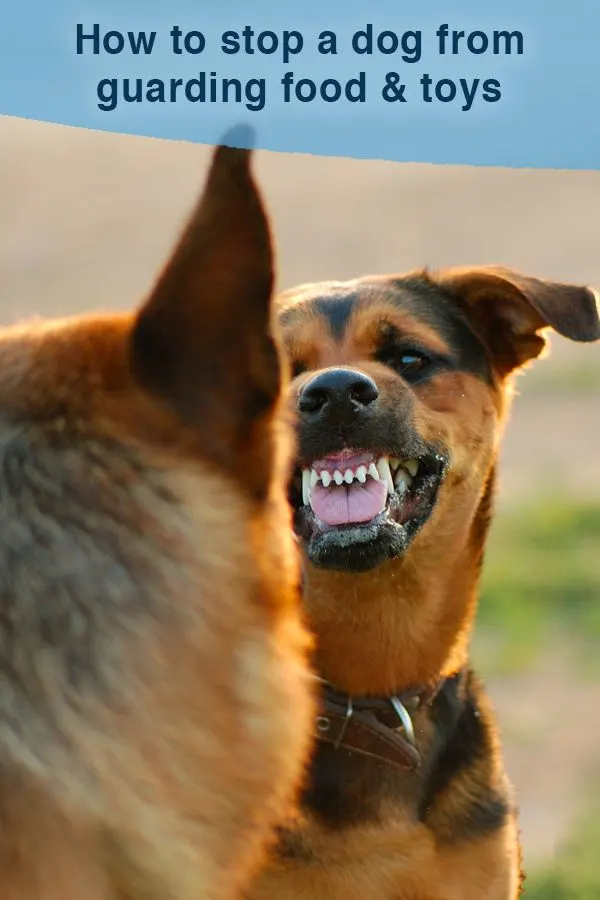
Some dogs will follow through with a snap or a bite if they think a dog or person is trying to take the item. Others will lunge and bark ferociously, and some will just clamp onto the item refusing to let go.
Other signs to watch for include:
- running away to hide with the item
- raised hackles
- licking their lips
- raising their lips and showing teeth
- crouching or moving slowly
Possessiveness can range from barely noticeable to very serious aggression. Sometimes it’s only between other dogs and sometimes dogs are possessive to people as well.
Every dog and situation is unique, but my goal is to help you brainstorm ideas to help your own dog overcome possessiveness (often called resource guarding).
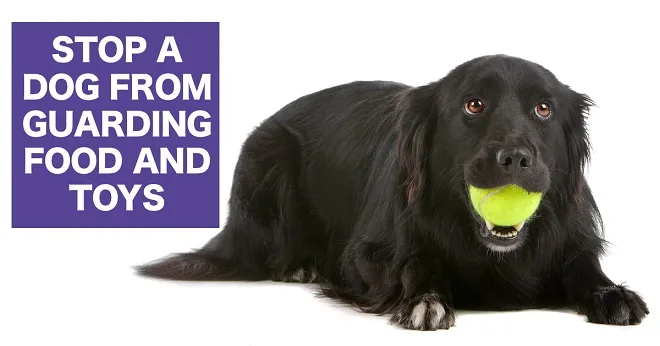
How to stop a dog’s possessive aggression of food or toys
If your dog guards or refuses to let go of certain items like toys, tennis balls or rawhides, the following suggestions should help decrease the behavior.
1. Start the “nothing is free” program
I prefer to use this method even when the dog is not possessive. It’s a good habit. Simply, the dog earns food, treats, toys and attention.
Yes, I give my dog plenty of affection when he doesn’t do anything first. However, we should try to make our dogs earn their food, toys and yes – our affection – at least some of the time. It’s a way to reinforce good manners and teach the dog self-control.
A lot of dogs that show possessiveness of food or toys do not have a high level of self control in general. They believe it is OK to take what they want. It’s our job to teach them patience will bring them lots of good things!
You sit, you get a treat! Lie down and wait, you get food. You make eye contact, OK, we can head out for a walk!
This post has been expanded into a FREE ebook on how to break a dog’s possessiveness. Get it here.
2. “Trade” the dog for something better
Do not hesitate to seek help from a professional trainer in your area if you are hesitant about approaching your aggressive dog. If you are tentative, your dog will likely pick up on that and usually the response is not what we’re looking for!
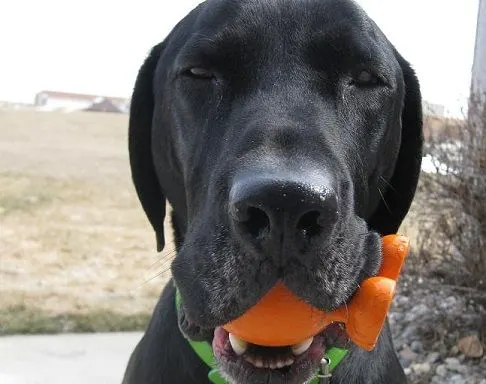
It’s hard to remove an object from your dog if she’s growling and snapping.
One way to take the item is to “trade” your dog for something even better than the original object such as pieces of chicken, beef or ham. If you use dog treats, choose a kind your dog really loves! I recommend Wellness Well Bites.
Approach your dog with the food, give a command such as “sit” and then when the dog drops the original object and sits, give him a jackpot of goodies from your hands or toss the food on the ground.
Since dogs only focus on one thing at a time, the dog will be rewarded for the most recent behavior, the “sit.” The dog will not be rewarded for possessiveness.
If you purposely set up these scenarios, you should have your dog on a leash for extra control in case he tries to grab the original object and run off.
Of course, you will need to practice this over and over again a few times per day over several weeks or even months to work on the dog’s possessiveness issue. Using a clicker will help your dog learn faster and speed up the training process (see below!).
3. Teach your possessive dog “leave it” and “drop”
When practicing the trading technique above, you can incorporate a command – drop.
The dog may not drop the object right away, but as you continue practicing the trading technique, the dog will be more willing to drop the original item.
This is when I recommend you start saying “drop.” The dog will already be doing the behavior, but you are adding the command.
The dog will eventually learn to “drop” on command with or without a treat. You should of course continue to use treats every now and then to keep the dog interested.
I also use the command “leave it” to mean “Do not touch.” This is easier to teach and practice, because you would give the command when the dog does not already have the object in his mouth. Then, reward the dog for showing self control and not touching the object.
With practice, you can eventually use “leave it” in many different contexts. You’ll just need to practice in different environments and with different items slowly over several weeks and months.
See my post: How to teach the drop command.
4. Train your possessive dog to drop items using a clicker
Using a clicker for stopping a dog’s possessiveness is very helpful, even if you are normally not a “clicker trainer.”
I currently have a weimaraner who picks up random objects like socks or pieces of trash and becomes obsessed with these items, refusing to drop them.
Clicker training has been the most effective training method with him for working on “drop” and “leave it.”
The way it works is you “click” the moment your dog drops the item and then give a treat. The click sound marks the exact moment your dog does the correct behavior and he learns to associate the “click” with receiving a treat. Get a Mighty Paw clicker here.
See my post: common clicker training mistakes
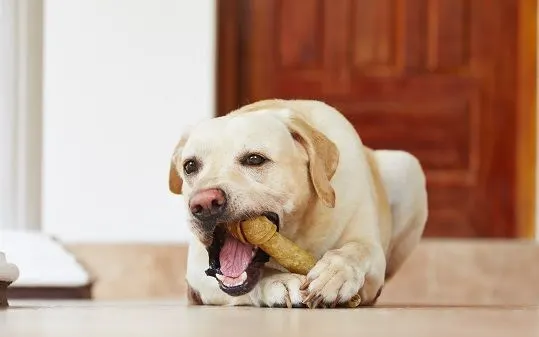
*This article has been expanded into a FREE ebook on how to break a dog’s possessiveness. Get it here.
5. Desensitization and counter conditioning for resource guarding dogs
Your dog might be so aggressive that the trading technique above is not working. One thing you can consider is setting up a desensitization plan.
This type of training takes several weeks to work, so you need a lot of patience, and don’t hesitate to get some advice from a local trainer.
The idea is to set up scenarios where the dog is likely to become possessive.
For example, if the dog is possessive of rawhides, you’re going to have to present rawhides to him every day and work to desensitize him. Behaviorist Dr. Patricia McConnell has an excellent post on how this desensitization and classical conditioning process works in dogs. I wrote a summary of her post here.
Here’s what you would do:
- Put your dog’s leash on him. Then, give your dog a rawhide and leave the room.
- Next, return to the room with a stock of highly valued treats (like pieces of beef or string cheese).
- Walk up to your dog but stop before he has a chance to guard the rawhide. That distance will be different depending on the dog. You want to stop before he stiffens up.
- Toss him a treat so it lands right by his mouth, and then walk away. You want the dog to think, “No! Don’t go away! Keep giving me treats!” This will only work if you can find food that is “better” than the rawhide.
- Over several days or weeks, you would continue to get closer to the dog until he is OK with you approaching while he has the rawhide.
- Practice just 5 mins a day over many weeks.
*This article has been expanded into a FREE ebook on how to break a dog’s possessiveness. Get it here.
6. Don’t allow a dog to resource guard items that “belong” to him
Be careful not to make excuses for your dog and allow possessiveness of objects that “belong” to him.
For example, just because the tennis ball “belongs” to the dog, that doesn’t give the dog permission to snap at someone who tries to take it. It’s a good rule that people should always be allowed to take anything from the dog.
I’ve had some readers tell me their dogs were possessive of stuffed animals because the dogs thought the toys were their babies. While that may be true on occasion, it’s still not OK for the dog to show aggression over a toy.
7. Help the possessive dog achieve a high level of obedience
This goes along with self control and the “nothing is free” idea.
Dogs that come when called, stay when told and walk nicely on a leash have a higher level of self control than other dogs. This means they also have a higher level of respect for their owners, and they (generally) have better manners.
If your dog has a problem with possessiveness, one of the first things you should consider is his level of obedience. Does he stay when told 99 percent of the time when on a leash? If not, then how can you expect him to listen to you when he’s off leash?
Does he come when called even with distractions? Now you know where you have work to do.
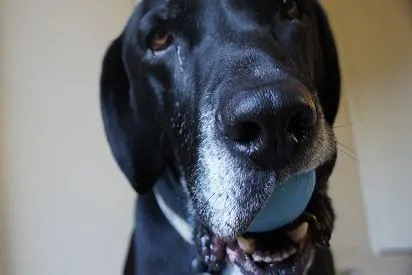
In order to help your dog improve his manners overall, it is absolutely necessary to work on his basic obedience first. If you need some help, it’s OK to attend an obedience class or work one-on-one with a trainer.
8. “Claim” anything you give your possessive dog
This is not complicated or mean. It’s just a subtle communication to the dog – “OK, I see. That toy belongs to the human.”
For example, before giving your dog a toy, you could ask the dog to sit. This puts the dog into a calmer state of mind. If the dog accepts the toy in a calm state of mind, he is more likely to remain in that state and play with the toy calmly.
A calm dog is less likely to become possessive and reactive than an excited dog.
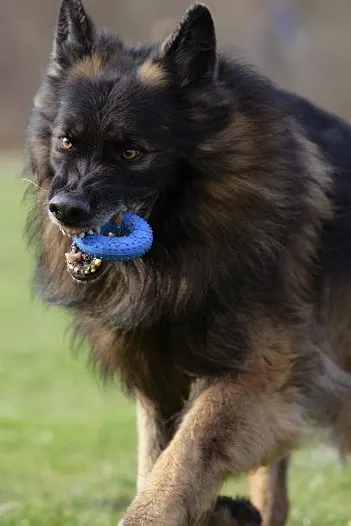
As another example, you could ask your dog to wait before eating. Once you place the bowl on the ground, do not allow your dog to charge the bowl. Simply, ask for some space.
You can do this by standing over the bowl calmly but confidently. Or, you can tell your dog to sit before you calmly release him to get the food.
While the dog is eating, you should ask him to stop and back away or sit again. This teaches the dog that you can take the food at any time. Just make sure to give the food back as a reward, or drop in something that’s even better, like real chicken!
9. Do not make up excuses for your dog’s resource guarding or aggression
Small problems lead to bigger problems when dog owners do not take a dog’s mild aggression or possessive issues seriously.
Of course, some dogs sound aggressive when they are playing with toys. This is normal as long as the dog is just playing and will allow you to take the toy and end the game at any time.
For more information, see my post on why does my dog growl at other dogs?
10. Hire a professional trainer to stop a dog’s resource guarding
Aggression is serious, and I do not want anyone to get hurt. A professional trainer will be able to evaluate your dog and tell you some additional ideas for your unique situation.
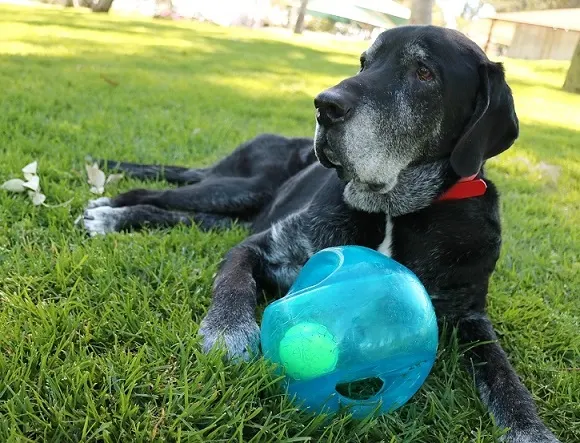
One of my foster dogs was showing some severe possessiveness, and even though I have a lot of experience with dogs it was nice to consult with a trainer for some extra ideas.
When you don’t live with the dog, it’s easier to notice things the owner may not see. A good trainer will observe you and your dog in a biased, non-emotional way.
11. What about correcting the dog’s possessiveness?
When correcting a dog that is showing possessiveness, you need to be careful because using force can bring out additional frustration or fear from the dog. Frustrated or fearful dogs are more likely to bite.
It’s all about timing. Ideally, you would step in and block or give a calm, firm “no” or “leave it” before your dog has a chance to grab or guard an item.
That way you’ve removed his chance to guard the item and you can actually reward him for a more appropriate behavior like sitting or backing away.
With your dog on a leash, you could even set up these types of scenarios and practice in short sessions a few times per day. Dogs need a lot of repetitions before a behavior becomes conditioned, so be patient.
What if the dog already has the item in his mouth?
Generally, I don’t recommend correcting a dog at this point. Instead, use one of the other techniques I mentioned above such as trading your dog for something else of higher value such as real meat.
For some dogs, a firm “no” or “drop” will work or even a firm tug on the leash as a correction. Then reward your dog with a treat for dropping the item.
If he doesn’t release, do not keep tugging on his leash because there’s not a great outcome from this. At best, your dog might drop the item eventually, but in the process you’ve caused even more arousal or fear from your dog. Some will become more aggressive.
In an absolute emergency where you need to prevent your dog from swallowing a dangerous item, you can gently pull up on your dog’s collar, raising your dog’s front legs off the ground.
You are essentially cutting off his airway and you can even pinch his nose at the same time. I’m hesitant to mention this because someone will take it out of context but it does work in an emergency. Almost all dogs will drop the item in this scenario.
Obviously this can bring out more frustration in a dog and the potential for a bite, so I do not recommend this technique unless you truly have no other option.
See my post: my dog swallowed a sock!
How to stop a dog from being possessive of owner
One last thing, what if the dog’s possessiveness is over the owner? For example, what if your dog growls and lunges at people who get too close to you?
If that is the case, you can certainly work on using counter-conditioning and desensitization like I mentioned above (#5).
You’ll just need to recruit some helpers. Your helper would approach you while your dog is in your lap or at your feet. She should toss a treat to your dog before he has a chance to guard you and then walk away.
An issue with dogs that guard their owners is they’re often acting out of fear. They’re afraid of new people and feel more confident or powerful when they’re leaning into their owner or sitting in the owner’s lap. They growl and bark at strangers out of fear.
If you have a small dog, I recommend you block him from sitting in your lap and guarding you. Likewise, if you have a dog that guards you from your feet, do not allow him to do this. Instead, get up and sit somewhere else or put your dog in a down/stay on a dog bed when you have people over.
I have written a blog post about small dogs guarding their owners, and I also recommend the books “Feisty Fido” and “Cautious Canine” by Patricia McConnell.
What do you do to prevent a dog’s possessiveness?
Let me know in the comments.
*This article has been expanded into a FREE ebook on how to break a dog’s possessiveness. Get it here.
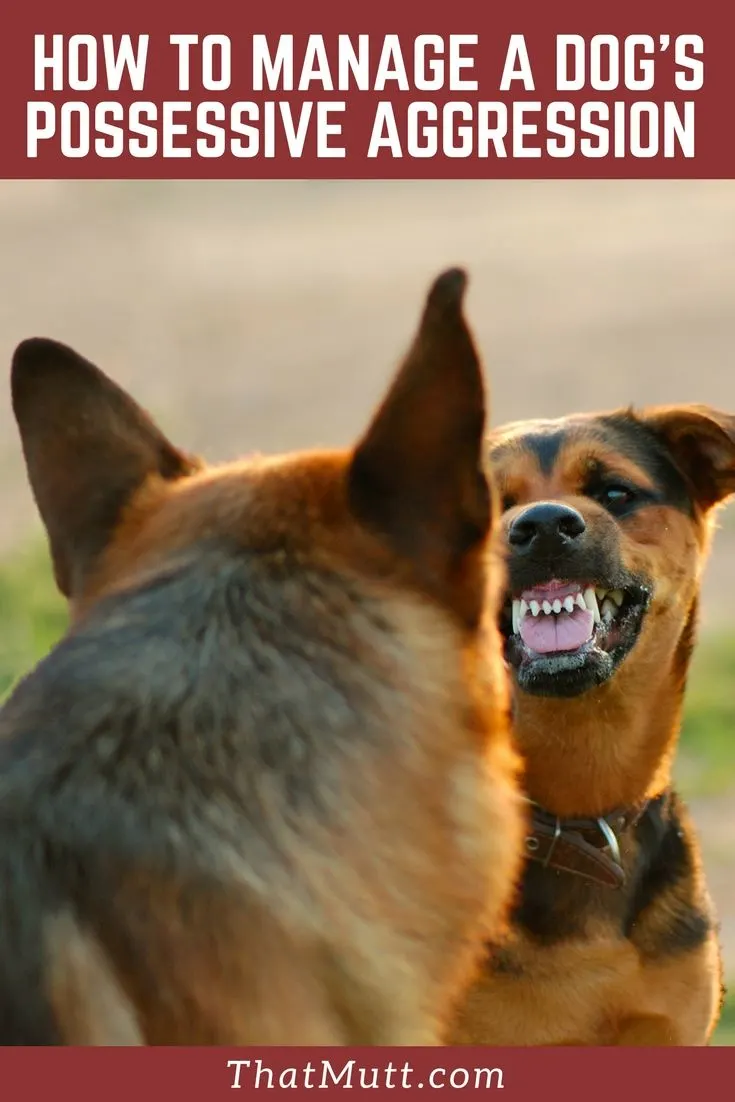
Best training tools to stop resource guarding
- High-value treats!
I recommend the brand Wellness Well Bites when you work with your dog on “drop”, “leave it” and trading them. - Treat pouch.
Use a treat bag to conveniently hold all your treats during your training sessions. - Clicker.
Use the clicker to mark the exact moment your dog does the correct behavior. In our case, it’s “drop” or “leave it.” Followed by a treat!
More resources on a dog’s possessiveness:
- Teach a dog the “drop” command
- Stop a dog from guarding her owner
- Stop a dog’s toy guarding at the dog park
- Prevent a dog from guarding food or toys
- Dog to dog resource guarding – Patricia McConnell
Lindsay Stordahl is the founder of That Mutt. She writes about dog training, dog exercise and feeding a healthy raw diet.

Bernice
Friday 18th of August 2023
We’ve done all of these things listed about. He’s turning 2, and it’s getting old and still unsafe for my grandchildren and my other dogs.
Bernice
Friday 18th of August 2023
Are there dogs that just have mental issues that shouldn’t be around children?
Brenda Scott
Saturday 21st of January 2023
Our 2 yr old male German Shepherd growls at us when we touch his collar or need to remove it to add tags etc. How do we handle this?
Conni / Natasha
Saturday 12th of November 2022
Your obviously a trainer. Have a 6 yr old rottie who is personality personified. Friendliest most loving lap dog u ever want to meet. However she has ao many toys around house, they are not allowed outside. So when I go to let her out all I say is leave it, and she drops it no problem.but outside with a tennis ball and out other rotting n Shephard she run n snarl for it. They give up. Needless to say I've had to leave 2 dog parks when I brought her....ball and when I threw it other pups wanted to play, but she wasn't having it. No way. It's mine. This may be my own fault u tell me? None of my dogs were messed w thier food. It's thier food. They don't come into mine, we go go into thiers. Can we take it from them? Eh, if we really had to , but no. They tell you ,back off. We give them marrow bones at times. Once they have it, that's it ,you walk to close and the sound they make is horrific. They stop chewing, and stare. But we allowed that from a pup. , maybe it's wrong, but we feel they deserve some dignity. And don't have to be totally submissive. But we know how to handle it. No kids, no strangers. Leave them alone. Course I tease her..Lil I won't change my mind on this , I believe a dogderserves respect also. Last thing she is possessive of me. But I don't think it's fear aggression. She doesn't come close to me Specially men..tall men. And they'll run the day to shake my hand or lean down n kiss me. She listen to me, although she on guard. So doggy park if man walks over to say hi...I have to walk the other way. She's very protective. If I tell her Natasha it's OK. She'll back off ,but her eyes won't leave him . It's takes quite a while for her to warm up to a man... so I take my cues from her. Lol when were in park and a Donnybrook takes place with 3 or 4 dogs at once she get curious and look like she wants to go over, but I taught her a saying since she was a baby. Both our rotting. We say, Natasha, mind your bussiness!business!! Cause you know if she's in there and somebody gets hurt? Who they gonna blame? The rotting of course. When it's usually, and this is true, some little stinking terrier with little man's disease. Who started whole thing w thier big mouth.well. this ball thing really bothers me, and she she is the suit and will fight for that ball. I don't know how to get to toshare it. I would love to a comment back, maybe you can shed some lite. She's well behaved, extremely extremely loving n playful, always smiling. Her little nub is always shaking back n forth. You just can't bombard her if u don't know her. I tell everyone, keep your hands down. Don't reach over her heard to pet her. She has nipped. Lil nips , drew Lil blood but nipped. I think cause it whenalotof people are here or even 3 or 4... she acts so happy, wiggling that butt, smiling, going up to them. I think it's excitement, the no arched back lips going up, licking of the lips , she's happy as anything, then nip.nogrowl. then she's kissing her usually a woman . . I think she gets anxious and over exided... she's just so full of love. Best dog I ever had, smarted, protector I'm sold on them anyway I see there's no pace for email.so if anyone is a good trainer hit me up. Skyepn1607@ gmail.com Natasha & Connie. Thank you for allowing me to go in such a long dissertation. Oh, and p.s. she's beautiful I found email.
Margalit
Tuesday 13th of September 2022
I have a 5 month old mini labradoodle that is possessive of me against other dogs. If another dog comes up to me she’ll snap at them. How do I counter condition with dogs?
Puppy Training Timeline By Age – Pet Food & Training
Monday 28th of March 2022
[…] “Trading” valued toys and bones for even better treats! (to prevent resource guarding) […]